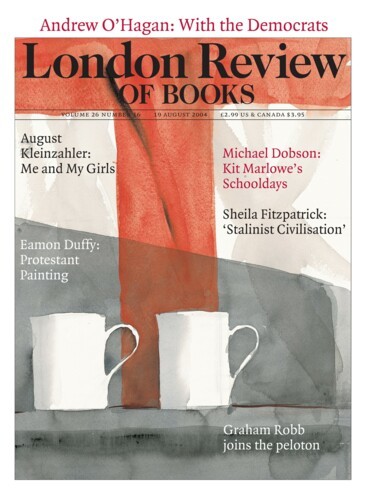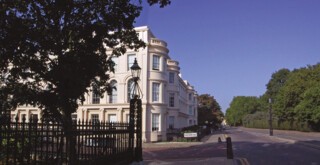In 1963 we bought a house in Southfields, a few hundred yards from the All England Lawn Tennis Club. Every year since then we have, for a fortnight, had to elbow our way crossly through tides of tennis fans. During those weeks, Wimbledon Park, which lies beyond the wall at the end of our street, is given over to cars. That invasion irritates me as much as the human traffic. The park is shared space, but it is our shared space. I resent the intrusion. It is not grand landscape: it is bordered on one side by the raised track of the District Line, on the other by Wimbledon Park golf course, and is laid out in sports pitches and a running track. But it’s a good place to throw a ball about and does have a lake where, once in a while, I check out the wildfowl.
Over the years the population has changed. Canada geese came years ago; now there are also Egyptian geese, and what I think are pink-foot geese. One winter I watched shoveller duck swimming round after each other in a circle. There are fewer tufted duck and mallard than there were. A couple of years ago, a pair of ruddy duck arrived: small, sexually aggressive stifftail ducks with bright blue bills. I saw a pair copulating the other day. Afterwards it seemed that the drake was struggling with a long pink worm; I remembered a piece of research that was in the press a year or so ago: not many birds have a penis, but the stifftail duck does – it can be longer than the bird itself and is not, it would seem, easy to manage. The penis of a relative of the ruddy duck – the Argentine lake duck (Oxyura vittata) is shaped like a corkscrew and, at almost half a metre long, is the largest of any bird so far measured. Seeing a vigorous ruddy duck at work explains the concern of ornithologists about its threat to the racial purity of its Spanish relation, the white-fronted duck.
The human population in the park changes, too. There is a rumour that the number of young Australians and South Africans in Southfields is in the tens of thousands. Whatever the figure, it has been enough to change the culture of the park. Solidly built, barefoot, in long baggy shorts and T-shirts, they play touch football, throw frisbees, practise rugby punts and run – often in pairs. Sports girls made to win Betjeman’s heart play the same games. The local Indian restaurant has become a grill room, with South African and Australian flags outside. The invaders are less colourful, but in their way just as exotic as the new geese and ducks. Like the birds they bring their problems. The geese leave droppings on the grass; the antipodean mini-barbecues leave burnt patches. They tend to party noisily. But I came from New Zealand: who am I to complain?
In parks all over London exiles and emigrants have found niches for rest and recreation. In Kew Gardens you find groups of picnicking Indians. They seem quite different from the football players in our park. Their movements are smoother, more contained. Like the flocks of parakeets (now a British breeding species) which call raucously and flap gaudily among the oaks of Bushey Park, the Asians are more brightly dressed than the native species. But they are seemly. The bare midriff, first seen as a regular thing among sari-wearers, is a distant forerunner of the naked area, now fashionable, that extends from the hip bone to somewhere above the navel. In hot weather, the parks are a temptation to people to strip off. The display of flesh can seem an offence against propriety – not propriety in general, but the particular propriety the grander parks assert. Landscape can demand decorum as effectively as dim light, pointed arches and pillared halls. If you haven’t met its demands, you can feel like human litter. In France they are clear about that – I remember being moved along by the wardens when we sat on the grass at Versailles. On the other hand, the back, arms and shoulders of young human beings can be so beautiful that were I to have the power to insist that people like me cover up, there would have to be a special dispensation for elegant young backs.
Stucco is the building material that frowns least heavily on new human fashions. When well kept, it does not spall or patinate, and hides brick the way our clothes hide flesh: it does not, like the stone of Bath or the pink brick of Albi, make modern passers-by look out of period. It was frowned on by Victorian architectural moralists who thought façade painting as disreputable as face painting. The great protagonist of urban stucco, the designer whose fresh-as-paint parks and park-side buildings are most generous to the changing appearance of the people around them, is John Nash. His career can be followed in the pictures in the late Michael Mansbridge’s illustrated catalogue of everything which has any claim to be by him.* He seems to have designed – in Great Russell Street – the first London buildings in which all the exterior brickwork, not just the basement and ground-floor walls, was plastered over. The Regent’s Park terraces, Carlton House Terrace, the Pavilion at Brighton and the miles of seaside stucco which have since lined much of the south coast of England with bright, bay-windowed ranges are jauntily festive, for all their weight of columns, pilasters, entablatures and pediments. From Regent’s Park and St James’s Park you see newly painted stucco gleam through the green. Before he became George IV’s favourite architect, Nash was a pioneer of the picturesque: houses with Gothick crenellations and groups of ornamental thatched cottages. Regent’s Park is also an exercise in the art of making a false impression. Neoclassical stucco fronts create palace façades from terraces of houses.
Nash seems never to have taken architecture entirely seriously. Although he was an adventurous and innovative engineer, some of the buildings he was responsible for were not well made. But as a scene-maker he was a genius. He began the democratisation of grandeur, a process that continued through the 19th century. Clubhouses modelled on Renaissance palaces and hotels as richly endowed as great town houses gave middling people the use of grand spaces. Nash was a developer as well as a designer, a man with a strong entrepreneurial instinct. Given the chance, he would have designed a great – or at least a showy – shopping mall. As it is, he established a paradigm for the relationship between urban architecture and open space.
Send Letters To:
The Editor
London Review of Books,
28 Little Russell Street
London, WC1A 2HN
letters@lrb.co.uk
Please include name, address, and a telephone number.


